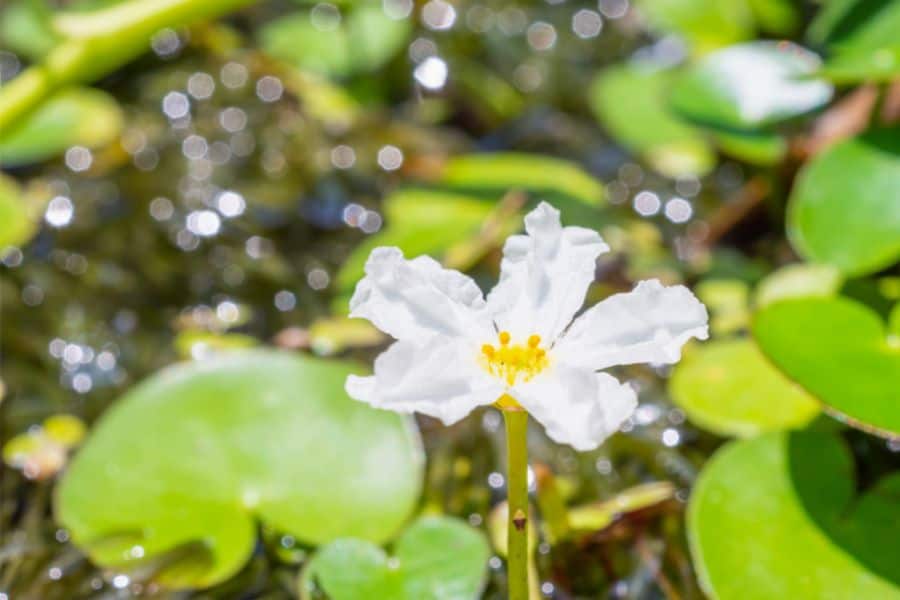Maybe you’ve one day come across an aquatic banana plant in your local fish store, but you’re not sure what it is you’re looking at and how to care for it.
In this article, we’ll show you what these plants are exactly, the best ways for you to care for them, and any problems you may have with the plant and how to fix them.
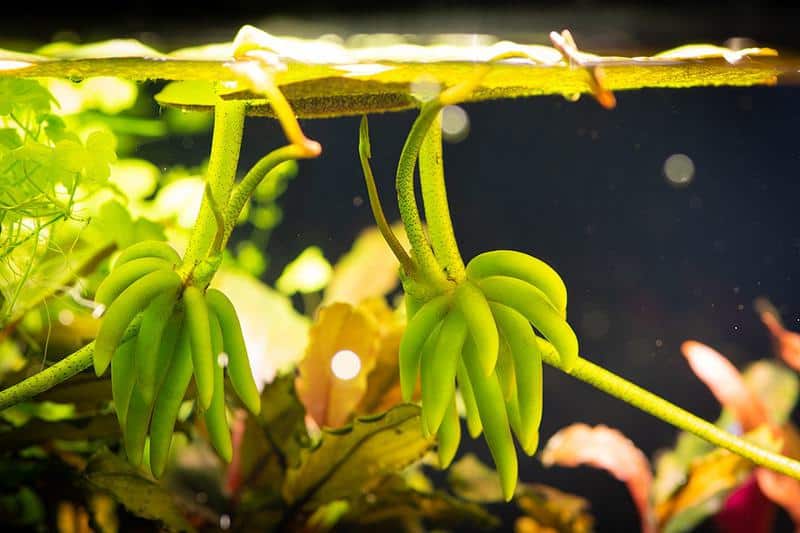
Aquatic banana plants are freshwater plants that have specialized tubers that resemble bananas and can go by many names. This plant is grown in relatively small aquariums and can sometimes be damaged by animals or have its tubers fall off.
Before we look at the best ways to care for this plant, let’s first have a better understanding of what this plant is exactly so that the later steps make sense.
What Are Aquatic Banana Plants?
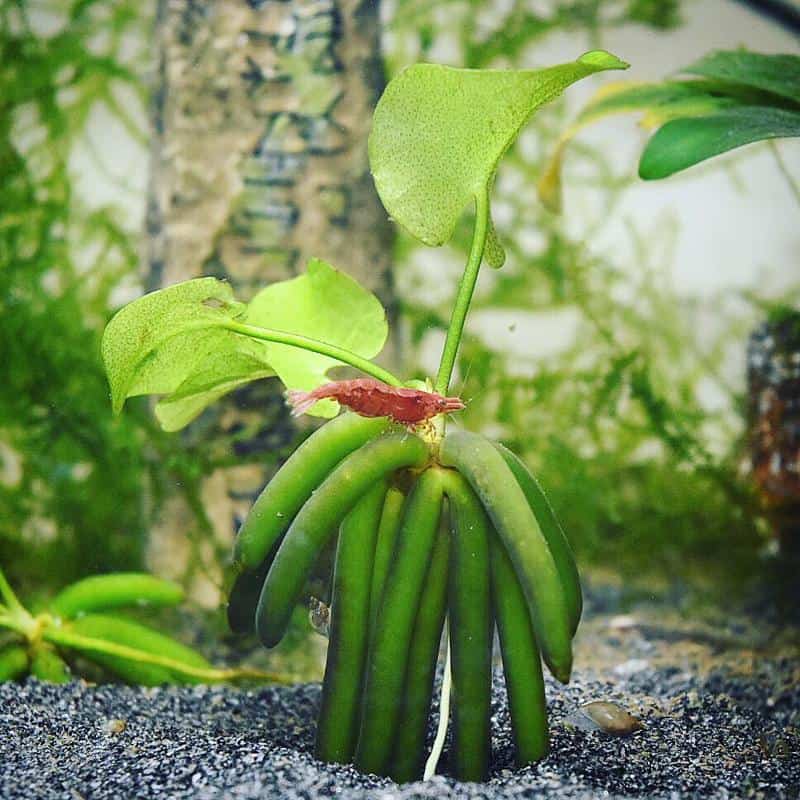
Aquatic banana plants are freshwater plants that are found in habitats such as lakes, ponds, swamps, slow rivers, or any other slow-moving bodies of water in the southern and southeastern United States.
Even though this plant is classified as endangered in its natural habitat, its surprisingly common in fish/pet stores and online. Not to worry, as these aquatic banana pants are grown only from the cuttings of other established plants, and are not removed from their natural habitat.
How Else is This Plant Known By?
Though we’ll use the term aquatic banana plants in this article, there are several other names for which this plant is sometimes known by. Here is a list of the ones you might see at your local fish/pet store or online:
- Aquatic banana plant
- Banana plant
- Freshwater banana plant
- Underwater banana plant
- Banana lily
- Heart water lily
- Big floating heart
- The brain plant
- Fairy water lily
- Aquarium banana plant (mostly known by professionals)
- Nymphoides aquatica / aquatica (scientific name; mostly known by professionals)
General Characteristics of the Plant
In order to summarize what this article is about, here’s a table that shows all the basic information we’ll be going over:
| Maintenance Level | Simple |
| Height | Up to 6” (varies on nutrient availability) |
| Width | Up to 4“ (varies on nutrient availability) |
| Water temperature | 68 to 82 degrees Fahrenheit |
| Water pH | 6.0-7.5 |
| Lighting Requirements | Low to High |
| Fertilizer | Liquid fertilizer and root tabs (optional) |
What Should You Be Looking For?
Aquatic banana plants have several features that make it stand out among other freshwater aquarium plants. Here are the traits that you should look for the next time you go out seeking one for your aquarium.
Aquatic Banana Plants Have Unique Tubers
Probably the most noticeable trait of aquatic banana plants, as well as its namesake, are its banana shaped tubers. These tubers look like a bunch of unripe bananas, with their light green coloration.
These tubers are the part of the plant where its nutrients are stored. Unlike what some may believe, these tubers are not the roots of the plant; in fact, if you plant them under your substrate, you’ll soon notice them starting to rot.
Now For the Actual Roots
The roots of the aquatic banana plant are admittedly rather inconspicuous as they pretty much appear just like the roots of any other plant.
Unlike the tubers, the roots usually begin as a white color and will turn green as they mature and become accustomed to the environment inside the aquarium. The roots grow from the base of the stem above the tubers and continue downward towards the substrate.
In the case of a floating banana plant, its roots can grow all the way down and reach the substrate, hence anchoring the plant in place.
Differently Shaped Leaves
Another trait that makes the aquatic banana plant stand out is its leaves.
While the plant will usually produce many leaves that remain underwater, it’ll often produce one stand out leaf that will grow an extremely long stem and shoot towards the water surface. Once the leaf has reached the surface, it’ll eventually unfurl into a lily pad within a week or so, hence why another nickname for this plant is the banana lily.
The stem has been observed growing up to 28 inches, so don’t be surprised if you see one stem sticking out from your plant.
These leaves are usually light to dark green in color (they darken as the plant matures) though some may develop a patchy red color. If you’re lucky, you may also find small white flowers that sit atop the surface of the water.
Aquarium Banana Plant Care
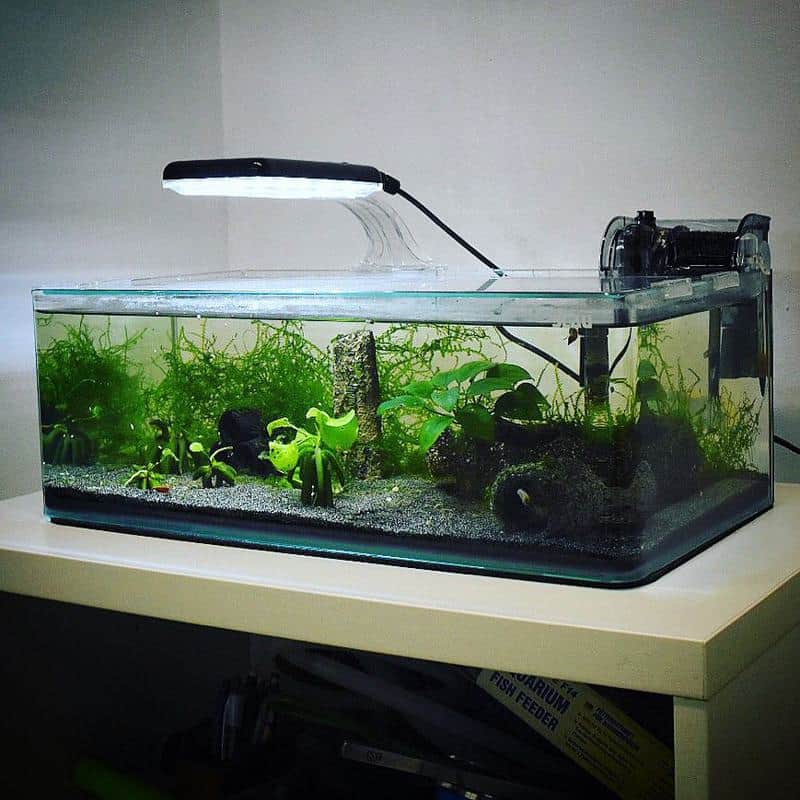
Planting and caring for your aquatic banana plant is a fairly simple process, but like all plants and animals, simple doesn’t mean you can ignore it completely.
Depriving the plant of its appropriate care can not only result in an unhealthy and dying plant, but also contaminate and pollute the rest of your aquarium as well.
Here are the materials you’ll most likely need to plant and manage your aquatic banana plant:
An Appropriately Sized Aquarium Tank
The first thing you’ll need to get, besides the plant itself, is an appropriately sized tank. As the plant only grows up to 6 inches in height and is not wide at all, a smaller tank (about 5 gallons or above) will work.
If you wish, you can place one of these plants into a betta tank, which start at 3 to 5 gallons.
Aquatic banana plants also do well in goldfish tanks as, due to the texture and thickness of the leaves, smaller goldfish won’t attempt to eat the plant, something rarely seen in other aquarium plants.
Use a Standard Filter and Aeration System
A standard filter and aeration system is enough for this plant. Though this plant alone is also a natural filtration system for the water, you shouldn’t depend on plants alone to be used as the primary filtration system for your aquarium.
When setting up your filter, remember to reduce the flow rate so that it won’t induce strong currents that can blow the lily pads around in your tank.
Use a Thermometer and a pH Meter
Though this plant can tolerate a wide range of water conditions, it’s important that you keep the temperature and pH of the aquarium water within the acceptable ranges of the plant. You can do this by using a thermometer and a pH meter.
Gravel, Sand, and Soil Substrates All Work
Gravel, sand, and soil substrates can all be used for aquatic banana plants. The substrate will large pebbles should be avoided as these plants cannot plant their roots in them.
Soil substrates don’t require fertilizer, but root tabs are recommended for gravel and sand.
Add Some Tankmates
The aquatic banana plant shares its tank well with both fast and slow growing freshwater plants. Examples can include Anubias, Hornwort, Java Moss, Java Fern, and the Amazon Sword plant.
Be careful not to overcrowd the tank, however, as it can lead to them competing for nutrients and lighting.
Low to High Lighting All Works
The aquatic banana plant can tolerate low to high amounts of light. Either artificial or natural will work, but for artificial, its recommended that you go with a 2-watt light with a spectrum between 5,000K and 7,000K.
Care Procedure
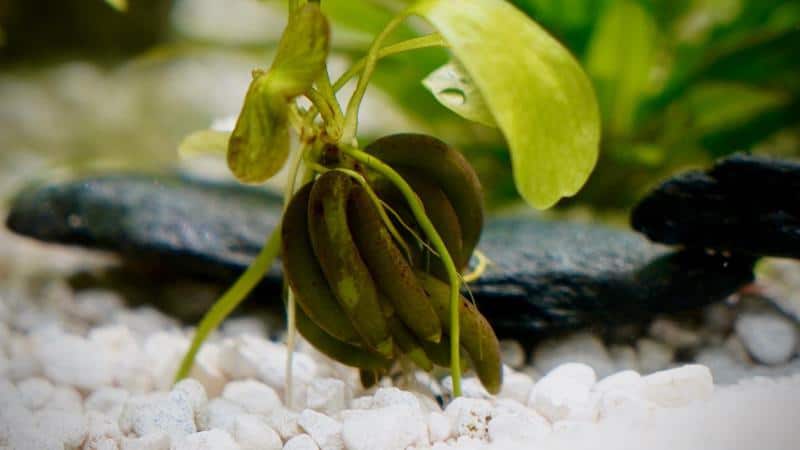
Now that you have an idea of what you’ll need, here are the steps to follow in order to successfully plant and manage your aquatic banana plant:
- If you choose to have a floating banana plant, be sure to use liquid fertilizer. Otherwise, follow the below steps if you wish to grow your plant in the substrate (recommended for beginners)
- If you’re growing the plant in soil, no fertilizer is required. Otherwise, if you’re using sand or gravel, be sure to use root tabs as these substrates contain no nutritional additives to the plant. Push the root tab into the substrate near the root of your plant so that it can release the nutrients your plant needs
- When planting your plant in substrate, keep in mind that no more than 1/3 of the tubers should be buried in the substrate. Any more and the tubers may begin to rot
- If you don’t wish your banana plant to float, you may use a plant weight, glue, or try tying it to a sturdy object
- The tethers may be removed once the plants roots have matured as they’ll be able to hold the plant down
- If you wish to have the plant grow lily leaves, its recommended to leave the plant under medium to high lighting (between 6 to 12 hours is best). Keep the light at low if you wish to have the leaves submerged
- Skipping the CO2 is another option to stunt the leaves’ growth
- If you already have a lily pad but wish to remove it, simply snip it and its stem using a pair of scissors
- The lighting will also change the color of your plant; the lower the lighting, the darker the coloration, and vice versa
- Keep the water temperature within the plant’s recommended range, but remember that the plant can tolerate temperatures as low as 50 degrees F (its growth will be stunted though)
- Reduce the flow rate of your filter as necessary so that it doesn’t create fast water currents that can disturb the plant
Read More:
FAQs
1. How Can You Propagate Your Plant?
In order to propagate your plant, wait until you have a lily pad developed on the surface of the water. Once it’s matured, cut the stalk while leaving at least 4 inches of it left.
Leave the bit you cut off inside your aquarium and let it sit for a few weeks. Once you notice roots forming at the base of the stalk, plant those roots into the substrate. Be sure to keep a low water flow, use liquid fertilizer, and use the medium to high lighting in order to maximize your chances of successful propagation.
2. What Animals Might Be Damaging Your Plant(s)?
If you’ve ever come home and noticed bite marks on your aquatic banana plant’s leaves, know that you most likely have an infestation of either snails or plecos.
3. Why Are Your Plant’s Tubers Falling Off?
One reason is that your plant is getting excess nutrients from the substrate and water. If your plant is getting sufficient nutrients, then the tubers, which store excess nutrients in cases of emergency, may fall off as they’re no longer necessary.
Another reason might be that, instead of an aquatic banana plant, you may have a similar looking yellow waterlily (N. mexicana), which is known to shed its tubers.
Conclusion
The aquatic banana plant is relatively easy to care for, and can make your aquarium a much more attractive home to the fish and other animals living in it.
As long as you follow the instructions in this article, you should have no trouble taking care of your new plant.
